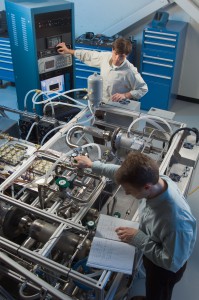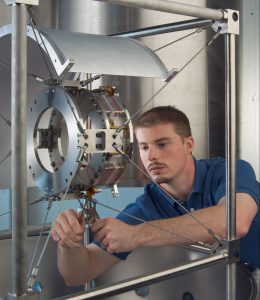Creare LLC is a leading innovator in the design and development of custom cryogenic components and systems. Our expertise covers vacuum systems, heat exchangers, control systems, and turbo-Brayton and other cryocoolers. Creare develops systems with operating temperatures down to 4 K and cooling capacities from a few milliwatts to several kilowatts. We have designed and developed cryocoolers for long-life space missions and low-cost terrestrial applications. Our complete cryogenic services range from conceptual design, analysis, and optimization to hardware development, fabrication and testing.
Customers value our ability to solve their toughest engineering challenges to innovate new products.
How can we help you? Call us at (603) 643-3800 for a free consultation. Or, if you prefer, fill out our contact form.
Creare is the world leader in reverse-Brayton cycle cryocoolers. We have developed cryocoolers for space, aircraft and terrestrial applications with cooling loads from 1 kW at 100 K to 300 mW at 10 K.
A key feature of these cryocoolers is the high-speed, gas-bearing turbomachines. Rotors of 2 to 25 mm diameter rotate at speeds of between 1,000 and 10,000 rev/s on a film of gas to provide long-life operation without wear or vibration. Endurance tests have demonstrated more than 14 years of nearly continuous operation without wear. Advanced developments are targeted at cooling temperatures as low as 4 K.
Creare has extensive experience in the development of cryocoolers based on the Joule-Thomson (JT) cycle over a broad temperature range. We select the working fluid to have optimal characteristics at the desired temperature and design specialized compressors, heat exchangers, and expansion valves to match tip geometries. Applications of our JT systems include gas liquefaction, zero-venting cryogen storage, radiation detector cooling, and infrared detector cooling.
Creare has developed an innovative dilution cycle that produces cooling by mixing a refrigerant fluid with another fluid to reduce the partial pressure of the former refrigerant flow. The second fluid can be subsequently separated from the mixture through a non-mechanical process, such as an electrochemical process. This approach enables a new type of cryocooler with no moving parts that can provide cooling down to about 20K, ideal for sensitive cryogenic detectors.
We have also designed and built components for magnetic cryocoolers. We take advantage of the magneto-caloric effect to build vibration-free coolers that have high efficiency down to 2 K. To build these systems, we use bi-directional circulators and special magnetic regenerators. The resulting coolers have application in sensors for space science.
Creare has designed, fabricated and fielded Stirling cycle (including the Pulse-Tube variant) refrigerators and components for applications such as gas liquefaction, cooling of RF devices, and the cooling of high temperature superconducting materials. Our work has generally focused on low operating temperatures in the range of 4 to 30 K. We developed and delivered to NASA in 1993 an innovative high reliability Stirling cycle cryocooler capable of providing 0.3 W of cooling at 30 K. More recently, we have developed and demonstrated advanced components for Stirling cryocoolers. These components included tactical electronics for single and multi-stage cryocoolers and regenerators for operating temperatures near 4 K.

Testing of a compact, airworthy distillation system for producing oxygen and nitrogen.
Creare has developed a number of advanced gas separation and storage technologies using cryogenic distillation, semipermeable membranes, and molecular sieve systems to meet the needs of aircraft, mobile hospitals, home oxygen therapy, and remote servicing applications. On aircraft, nitrogen is used for fuel tank inerting, and oxygen for emergency breathing, aeromedical use, and special operations missions requiring oxygen prebreathing. To address these needs, we have developed large-scale Onboard Oxygen Generating Systems (OBOGS) and Onboard Inert Gas Generating Systems (OBIGGS) that are high-capacity gas separation systems integrated into the aircraft.
For other applications, such as home oxygen therapy and mobile medevac operations, minimizing the system power, weight, and size is critical. Correspondingly, these smaller-scale applications require significant engineering innovation to address their unique constraints and requirements.

Assembling a thermal management system for a high temperature superconducting magnet.
High-temperature superconducting (HTS) materials have the potential to revolutionize the way we generate, transmit, and consume electric power. Transformational HTS initiatives span a broad range of applications that include power conditioning and transmission systems, large-scale offshore wind turbines, high-efficiency data centers, Navy ship systems, and turboelectric aircraft. One of the key challenges in any HTS system is maintaining the HTS conductors at cryogenic temperatures. As a result, cryocoolers are a key enabling component in any superconducting system.
Creare is the technology leader in the development of turbo-Brayton cryocoolers, which offer many advantages for HTS applications. We recently designed and demonstrated key components for HTS cryocoolers for Navy ships systems and future turboelectric aircraft. In addition to cryocoolers, we are also developing many of the other components needed for an HTS system, including cables, cryostats, field-serviceable connections, quick disconnect connectors, current leads, heat exchangers, and cryogenic circulators.